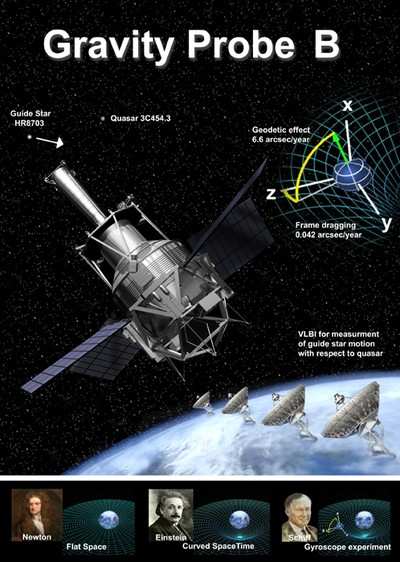Geodetic Effect, Frame-Dragging Both Proven By The
Spacecraft
 NASA's Gravity Probe B (GP-B) mission has confirmed two key
predictions derived from Albert Einstein's general theory of
relativity, which the spacecraft was designed to test. The
experiment, launched in 2004, used four ultra-precise gyroscopes to
measure the hypothesized geodetic effect, the warping of space and
time around a gravitational body, and frame-dragging, the amount a
spinning object pulls space and time with it as it rotates.
NASA's Gravity Probe B (GP-B) mission has confirmed two key
predictions derived from Albert Einstein's general theory of
relativity, which the spacecraft was designed to test. The
experiment, launched in 2004, used four ultra-precise gyroscopes to
measure the hypothesized geodetic effect, the warping of space and
time around a gravitational body, and frame-dragging, the amount a
spinning object pulls space and time with it as it rotates.
GP-B determined both effects with unprecedented precision by
pointing at a single star, IM Pegasi, while in a polar orbit around
Earth. If gravity did not affect space and time, GP-B's gyroscopes
would point in the same direction forever while in orbit. But in
confirmation of Einstein's theories, the gyroscopes experienced
measurable, minute changes in the direction of their spin, while
Earth's gravity pulled at them.
The findings are online in the journal Physical Review
Letters.
"Imagine the Earth as if it were immersed in honey. As the
planet rotates, the honey around it would swirl, and it's the same
with space and time," said Francis Everitt, GP-B principal
investigator at Stanford University. "GP-B confirmed two of the
most profound predictions of Einstein's universe, having
far-reaching implications across astrophysics research. Likewise,
the decades of technological innovation behind the mission will
have a lasting legacy on Earth and in space."
GP-B is one of the longest running projects in NASA history,
with agency involvement starting in the fall of 1963 with initial
funding to develop a relativity gyroscope experiment. Subsequent
decades of development led to groundbreaking technologies to
control environmental disturbances on spacecraft, such as
aerodynamic drag, magnetic fields and thermal variations. The
mission's star tracker and gyroscopes were the most precise ever
designed and produced.

GP-B completed its data collection operations and was
decommissioned in December 2010. "The mission results will have a
long-term impact on the work of theoretical physicists," said Bill
Danchi, senior astrophysicist and program scientist at NASA
Headquarters in Washington. "Every future challenge to Einstein's
theories of general relativity will have to seek more precise
measurements than the remarkable work GP-B accomplished."
Innovations enabled by GP-B have been used in GPS technologies
that allow airplanes to land unaided. Additional GP-B technologies
were applied to NASA's Cosmic Background Explorer mission, which
accurately determined the universe's background radiation. That
measurement is the underpinning of the big-bang theory, and led to
the Nobel Prize for NASA physicist John Mather.
The drag-free satellite concept pioneered by GP-B made a number
of Earth-observing satellites possible, including NASA's Gravity
Recovery and Climate Experiment and the European Space Agency's
Gravity field and steady-state Ocean Circulation Explorer. These
satellites provide the most precise measurements of the shape of
the Earth, critical for precise navigation on land and sea, and
understanding the relationship between ocean circulation and
climate patterns.
GP-B also advanced the frontiers of knowledge and provided a
practical training ground for 100 doctoral students and 15 master's
degree candidates at universities across the United States. More
than 350 undergraduates and more than four dozen high school
students also worked on the project with leading scientists and
aerospace engineers from industry and government. One undergraduate
student who worked on GP-B became the first female astronaut in
space, Sally Ride. Another was Eric Cornell who won the Nobel Prize
in Physics in 2001.
"GP-B adds to the knowledge base on relativity in important ways
and its positive impact will be felt in the careers of students
whose educations were enriched by the project," said Ed Weiler,
associate administrator for the Science Mission Directorate at NASA
Headquarters.
 Airbus Racer Helicopter Demonstrator First Flight Part of Clean Sky 2 Initiative
Airbus Racer Helicopter Demonstrator First Flight Part of Clean Sky 2 Initiative Diamond's Electric DA40 Finds Fans at Dübendorf
Diamond's Electric DA40 Finds Fans at Dübendorf ANN's Daily Aero-Term (04.23.24): Line Up And Wait (LUAW)
ANN's Daily Aero-Term (04.23.24): Line Up And Wait (LUAW) NTSB Final Report: Extra Flugzeugbau GMBH EA300/L
NTSB Final Report: Extra Flugzeugbau GMBH EA300/L Classic Aero-TV: 'Never Give Up' - Advice From Two of FedEx's Female Captains
Classic Aero-TV: 'Never Give Up' - Advice From Two of FedEx's Female Captains




